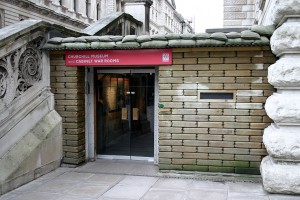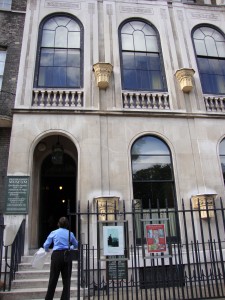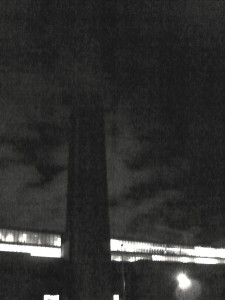Today I explored the Notting Hill area and I could imagine it as a vibrant but mostly quiet neighborhood. This holiday weekend however it was transformed by the Carnival that takes over the streets. Carnival has been held annually for almost fifty years and has exploded into one of the largest festivals in London. The event was originally a local West Indian festival that now draws hundreds of vendors in twenty square miles of streets. The streets explode with people, music, and the smells of traditional Caribbean food like jerked chicken or curried goat. The festival goes on for three days the largest and busiest being Monday. I went on Sunday which is considered the children’s day, so the parades were made up of children who would dance down the streets with each different group in charge of a different theme. Due to the massive amounts of people attending the festival the crowds also draw a strong police presence and varying reactions from the residents.
Multiple houses and stores had plywood up in front of their storefronts or the gates of the houses to stop people from entering their yards or defacing their property. Certain streets were cordoned off so that only residents were allowed to enter those sections. What was truly surprising was the variety of participants. A huge portion of the visitors were white Brits interspersed with a multitude of ethnic groups including Indian and Muslim, so identified by the bright saris and full hijabs. However after the initial parade another passed later filled with not just members of the black London population but Caucasian and other groups as well. It was incredible to see an event that can trace its roots back to a small local event for the area to what is now a major attraction to the entire city.
Tags: Uncategorized
August 30th, 2009 · 1 Comment
I’ve noticed that my blogs tend to have an incredibly critical tone to them. As a person who usually is quite positive and tries to find the good in all situations, such a pattern is a bit upsetting or at least surprising to me. Thank goodness for the Cabinet War Rooms offering me the chance to mix up the tone a bit. What seems to be most upsetting to me about certain places I have visited while in England is if that place operates behind a façade of what it really is. St. James’ Park is beautiful and promises peaceful relaxation but is only enjoyed by a select few. Bath is beautiful because that’s what tourists want to see. The Cabinet War Rooms are a bit on the pricier side of the spectrum so admittance could be seen as selective in ways. But assuming you have the twelve pounds and some change to get in, you’re guaranteed to see and experience all that the rooms were during World War II. That sense of ‘real-ness’ is something I most appreciated about the museum. The Blitz completely changed the London atmosphere during WWII, and somehow the museum was able to capture the feelings of anxiety that one can only imagine were present in the city at that time.

Outside view of The Cabinet War Rooms
Upon entering the museum, a feeling of eerie tension is almost inescapable. A most unpleasant guard very solemnly asked to look through my bag before I was to be admitted into the museum. I cracked an admittedly bad joke about how many maps I was carrying in it and how that might be difficult to look around in the bag. Laughter, a smile, even a twinkle of the eye was completely absent in his reaction. I recognize that he must get similar jokes all the time but his stern mood definitely set the mood for what was to come in the rest of the museum. Now, this may seem an odd experience to enter into the blog especially when I’m hoping to highlight how wonderful the museum was. Truly, I would have appreciated if he had acknowledged my attempt at being friendly but I think it’s actually good that he didn’t. The museum wasn’t a happy one. It shouldn’t have been. It was a preservation of a shelter that was put in place to ensure that communication and governance could continue in the case that an air raid might occur. As the Blitz is still a very real and felt occurrence in London’s history, the museum that seeks to capture that time should do that as fully as possible. So, having learned my lesson about keeping my jokes to myself, I proceeded through the rest of the museum. The lighting was dim, the people going through the museum quiet, the rooms closed off, and the lay out confusing. Again, this may sound like a negative review of the place but it’s exactly the opposite. More than any of the readings of personal accounts or facts about the destruction of the bombings, it was the tense atmosphere found in the museum that made the Blitz seem the most real to me. I was guided by a very thorough audio tour and yet still never knew where to go. Yes, this was frustrating but imagine how living and working in that space must have been. Churchill and his staff were living and working in that dreary underground space trying to carry on as positively and normally as possible. They were in the midst of a war with a threat of an air raid always present and surrounded by the people who are relying on them to not mess up. And if that isn’t enough pressure, they were underground- the situation could, arguably, not have been more confusing and frustrating. Those feelings are still alive in the museum. Yes, it’s a tad disconcerting to feel that strange in a museum but if you push past the feeling of ‘wow, I feel a bit uncomfortable’, you realize how fitting that feeling is for the location.
I realize that I took an odd way to describing a positive side of a museum by essentially saying “it was creepy but cool!” But that’s not so much the message. The message to me is that the museum successfully steered clear of any type of gimmicky portrayal of the war rooms and offered its visitors a chance to really sense what being in the war rooms might actually have been like. Now if only we can get rid of the cheesy gift shop and lower the price…I’ll save that for another post though.
Tags: Audrey · Museums

Churchill Bust
Today I visited both the Cabinet War Rooms/Churchill Museum and the Sir John Soane Museum and what struck me most about both of these very different museums was their presentation. The approach that these two museums took with presentation are very different from each other, and therefore striking in different ways. Having put on an exhibition myself during the past school year, I know the decisions involved in creating a show.
Although I visited both the Cabinet War Rooms and the Churchill Museum, I was much more impressed with the set up of the Churchill Museum, so that will be my focus here. Upon entering the Churchill Museum, the first thing I noticed was the color scheme: blue and grey/silver. This was continued throughout the exhibition which gave it cohesion and unity. This exhibit also mainly used interactive media like audio and video. My favorite section of the museum was the wall of black and white photos (keeping with the color scheme of the museum) that were back lit and place in deep silver frames. As you walked along the line of photos, motion sensors on the floor active clips from Churchill speeches that related to the photos. I found this combination of visual and audio stimulation to be very engaging.
Besides the color scheme, I also loved the various either lit up, scrolling, or painted Churchill quotes throughout the exhibition. Often when people picture art exhibitions they picture paintings and history exhibitions they picture photographs and artifacts. Adding text was just another way this exhibition engaged the audience successfully. As an English major and art minor, I found the quotes pleasing both because they were well chosen for their content, and also because they were presented in a very aesthetically pleasing way.

The Sir John Soane
The Soane Museum, on the other hand, had an equally engaging yet completely different layout. As opposed to the open, spacious, unified by color Churchill exhibit, the Sir John Soane Museum was in Soane’s home with tiny hallways, narrow stairwells, and rooms packed with busts and statues. Unfortunately no photographs were allowed in the museum, and only a photo could really convey the feeling of the museum—or home. That was the thing, this was the architect Sir John Soane’s home, more or less just the way he left it. The walls were covered in paintings and relief sculptures from various time periods. The banisters, tables, and other available wall space was covered in busts and other types of statues. Every windowsill and flat surface had something on it. The bookshelves were packed and the floors were all lined with various floral printed rugs. There was literally just enough room for a person to walk around the room or through the hallway. As I entered I had to place all my carried belongings in a plastic bag to be carried in front of me because there was not room enough for me to hold things at my sides as I walked. The stairwells winded around and as I walked, with my head always facing upward, I could not help but to think about the kind of man who would collect and appreciate these works of art, let alone live crammed in a house with them!
This exhibition overwhelmed me. I paced and paced around the house, and even saw a wall UNFOLD to reveal even more paintings! Most of the artwork was classical. Many of the paintings were landscapes. But it was not necessarily the artwork itself that made me love this museum, but the presentation. As I walked through the front door of the house and was instructed to turn off my mobile phone, I suddenly had this feeling that I was going through the wardrobe into Narnia. It was no longer busy modern London, it was 18th century England. The small spaces kept the museum goers quite, and I had a feeling of calm silence and awe as I entered room after room of wall to wall, floor to ceiling, art. Really, what could be better than that?
Ultimately I know that neither the content of the historical Churchill Museum or the classical busts and landscapes of the Sir John Soane Museum would have captivated me nearly as much had they not each been presented in such engaging ways. When it comes to being good at something practice, practice, practice. And when it comes to an exhibition its presentation, presentation, presentation!
Below is a slideshow of photos from the CHurchill Museum.
Tags: Megan · Museums
I realized that I forgot to discuss at any length my trip to various art museums in London. So, here is an account of my foray into the wider world of art—according to Britain.

The National Gallery looks out onto Trafalgar Square (find a history of the building here). The building itself is massive and houses thousands of paintings in room after room. The group that I went with found themselves lost in the maze of interconnected rooms. Sure, the collections are divided by period, but when one was distracted by William Turner or Titian, one room seemingly spilled out into the next. Disoriented and confused, it often took several minutes before we could find our way out of the labyrinth.
I should note that we only saw about twenty, maybe thirty, percent of the museum. We were warned that you could spend hours and even days on end in the museum but never truly heeded the warning.
Tired and ragged, we trekked on to the National Portrait Gallery. I should pause for a moment, for I went into this museum with low expectations. I never expected this museum to house any works of art but the typical “woman-seated-staring-at-a-diagonal” type of portrait. Or a bust of an obscure member of Parliament from the 18th century. I did not want to see this, to be honest, because I prefer art with sunlit scenery, some shock value, or images that did not focus solely on human features. I imagined myself walking mindlessly through halls lined with hundreds of identical portraits.
The National Portrait Gallery had all of that, but I’ve never been so wrong about a museum. I found paintings, photographs, busts and other, more abstract, media used to trace the human features of celebrities, average people, and, yes, even obscure members of Parliament. But even the people I did not recognize were immortalized by outstanding and, in many cases, awe-inspiring portraits and sculptures. Take, for instance, one of the paintings submitted to the 2009 BP Portrait Award. They were just incredible (here’s one example). This museum gracefully balanced the shocking and the more tame, the popularized and the relatively obscure. It’s all I ask for in a museum, and something rarely seen in art museums I have seen in the past.
This brings me to the next art museum I visited – the Tate Modern. Again, I think a pause is in order. Having only one course surveying the history of art since the Renaissance, I cannot declare myself all-knowing with regard to art. By the same token, I can appreciate all art. Especially when its definition is psychologically and visually questioned and, in some cases, shattered. I appreciate modern art for this reason; it tacks on an imminent and bold question mark next to the word “art,” and thereby forces us to question the painting/photograph/slideshow/etc. before us. “I could (never) do this” is often heard at these exhibits. As an art history professor explained to me during the course, these people (the Rothkos, Koons, and McCarthys) of the world) DID do it. And that is why it is art. Their expressions of limitless passion and angst and joy spill out into these exhibits, begging for a smiling or a wincing, almost riotous, audience.

The Tate Modern at night. Disturbingly brooding? Or pleasantly shocking?
Although I have studied art prior to visiting these museums, I looked for a distinctly “English” way of displaying art. Their art included famous works Americans can only view on posters or through a search on the Internet. Moving beyond that initial shock of standing before works including Turner’s “Rain, Steam and Speed”, you can look around and see throngs of art-hungry visitors to the museum. Look closer, and you hear French, Italian, and other languages. Crowds of people from across Europe and, more specifically, England fill the labyrinthine halls. Surely not everyone in London is an art connoisseur, but there’s certainly much diversity to be seen.
Whether you’re revolted or relaxed by the work, at least you had a reaction. Art is universal, it seems, whether you’re in America looking through great art in a book or you’re the very room containing that work.
_____________
If you are interested in some light reading, I suggest an article by Jack Handey in the New Yorker a few years ago. It’s pretty funny and mocks some of the more criticized aspects of modern art.
Tags: Brandon







